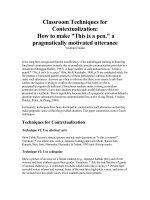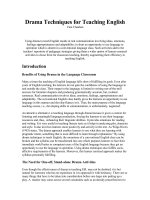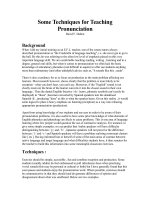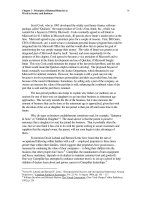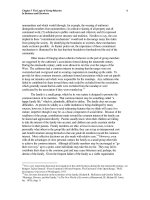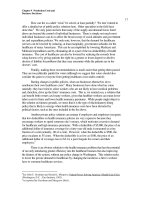Behavior-Management Techniques for Safe Schools ppt
Bạn đang xem bản rút gọn của tài liệu. Xem và tải ngay bản đầy đủ của tài liệu tại đây (1.57 MB, 12 trang )
Behavior-Management
Techniques for
Safe SchoolsEach new school year brings
high hopes, great expectations
and challenges for both new
and seasoned educators.
e American Federation
of Teachers (AFT) has
developed a series called
Classroom Tips to help
educators start the year
o right and anticipate
the year ahead.
Classroom Tips is
developed with you,
the educator, in mind.
e tips in this collec-
tion are taken from real
classroom experiences
and are part of the
AFT’s Educational
Research and Dissemination
(ER&D) professional
development program.
e AFT is a leader in providing
educators the resources they need to help them
succeed. Visit AFT’s Web site for classroom
resources at www.aft.org/tools4teachers
today.
Assigning Effective
Homework
Quality Classroom
Assessment
Techniques
Techniques
Loan Forgiveness
Creating a
Classroom Team
2 | AFT
S
chools remain one of the safest environ-
ments for children. However, in far too many
schools, a lack of respect for the authority of
teachers and other school employees, as well
as for the rights of other students, is undermining the
ability of schools to provide students with a quality
education.
Even in the best schools, employees often experience
frustration and feel abandoned in their eorts to
maintain a safe and orderly learning environment.
Many teachers can relate personal stories of adminis-
trators undermining their attempts to maintain order
by letting student oenders get away with disruptive
behavior.
Solving school violence and discipline problems isn’t
easy, but it can be done. Ultimately, it requires a
districtwide commitment to safe, orderly schools,
including a real eort by district ocials to stand
behind school employees with the support they
need—and a commitment by administrators to forge
a cooperative eort with school employees aimed at
educating students, parents and members of the
community about the need for tough but fair disci-
pline policies.
Effective
Behavior-Management
Techniques
Many behavior problems can be prevented or
corrected using eective behavior-management
strategies. ere are many practices—based on
research and demonstrated to work—that are
eective for preventing and correcting this behavior.
Techniques for managing the aggressive behavior
of students include prevention and intervention.
Prevention strategies focus on stopping the behavior
before it gets started; intervention techniques focus
on stopping the behavior after it gets started.
Classroom Tips | 3
Preventing Problem Behavior
Prevention strategies minimize the chances that
problems will occur. Such strategies include:
Creating a Structured Environment. Many chil-
dren with persistent behavior problems lead very
unpredictable lives. An organized environment
can replace their feelings of insecurity, mistrust
and discomfort, with predictability and stability.
Research shows that a predictable environment is
based on set rules and routines, and well-estab-
lished schedules and arrangements.
Monitoring Student Behavior. Research indi-
cates that continually checking children’s progress
over time allows adults to use this information to
adjust their interventions and improve their eec-
tiveness. It also is helpful to develop individual
behavior plans for children who present more
serious behavior problems, and to maintain writ-
ten records of specic events to assist in tracking
behavior.
Intervening in Problem
Behavior—Teaching
Alternative Behaviors
When individual children continue to act out in spite
of prevention measures, it becomes necessary to use
interventions to try to reshape their behavior.
Social Skills Training. Some children who do not
behave appropriately simply have never been taught
how to behave. ey have diculty developing
friendships, meeting adult expectations and dealing
with social problems appropriately. Teaching chil-
dren social skills helps them develop good relation-
ships with other children and adults. Research shows
that social skills instruction should include the
following steps:
Identify the social skills that are needed to replace
problem behavior. Decide which steps are nec-
essary for performing the skill. Ask students to
4 | AFT
remember the steps of the social skill. For exam-
ple, “Asking permission to leave your seat” may
include:
raising your hand; »
waiting to be recognized; »
asking permission to be dismissed; »
waiting for an answer; and »
asking questions if you do not understand »
the answer.
Model or show the students how to perform the
skill. Watching other children use appropriate
social skills and seeing them rewarded often leads
to imitation of those skills.
Practice: Allow the students to practice using the
skill through role-play situations.
Reinforce acceptable performance by letting
students know how well they are performing the
skills.
Anger-Management Training. Children whose
behavior is disruptive often have diculty expressing
anger in acceptable ways. When they were young,
many of these children learned that they could
control their world through anger. When people give
in to these children’s aggressive behavior, this
behavior is being rewarded, strengthening the
connection between anger and control. Many
children who exhibit aggressive behavior have never
learned acceptable ways of showing dissatisfaction,
frustration or anger. ey need coping skills for
resolving conicts without coercion,
physical force and aggression.
ese children need to recognize
the triggers that ignite their
anger and aggression, develop
strategies for managing their
anger, and avoid unnecessary
conict with others. Anger-
control strategies include:
Self-instruction: “Self-talk” and “self-prompting”
are ways of talking through problems using special
strategies. Students learn to engage in self-talk to
manage their anger. In other words, instead of tell-
ing themselves negative things, such as “e only
way out of this situation is to be more violent than
the other kid,” they learn to replace these negative
thoughts with positive ones.
Relaxation skills: Breathing and physical exer-
cises allow students to reduce both stress and the
physical symptoms of anger.
Social problem solving: is strategy helps stu-
dents view situations as problems to be solved and
not as battles to be won.
Providing Safe Learning
Environments Through
Prevention of Bullying
Creating an environment where all students feel safe
is extremely important to learning. Schools should
ensure that students never feel they are being bullied
by other students. Bullying refers to repeated aggres-
sive behaviors (physical, verbal or psychological)
meant to hurt another person. Bullying is signied by
an imbalance of power, often the result of dierences
in physical size and/or cognitive abilities.
6 | AFT
Characteristics of Bullies
ere typically are three types of people involved in
bullying behavior: bullies, victims and bystanders.
Bullies can best be dened by their personality style.
Researchers describe bullies as having the following
characteristics:
Enjoy aggression and the rewards gained from
aggressive acts;
Lack empathy for their victim;
Lack guilt for their actions;
Are dominating and like to be in charge;
Have aggressive role models; and
ink unrealistically about how the world should
meet their needs.
Victims of Bullying
ere are two types of victims: passive victims and
provocative victims. Passive victims generally do not
defend themselves and can be characterized by:
Being isolated during the school day;
Lacking social skills;
Being physically weak;
Crying or yielding easily to bullies;
Suering from past trauma; and/or
Having learning diculties.
Provocative victims generally tease and provoke
bullies, but do not have the social or physical skills
necessary to defend themselves. Provocative victims
can be characterized by:
Being easy to arouse emotionally;
Behaving in a manner that maintains the conict;
and/or
Classroom Tips | 7
Possibly having attention decit hyperactivity
disorder (ADHD).
Interventions for Bullying
Like most eective interventions, strategies to pre-
vent bullying should be comprehensive and multifac-
eted. is means that bullying interventions should
be implemented schoolwide, classroomwide and
individually; must include all sta, related personnel
and administrators; and should have input and com-
mitment from students and family members. Most
important, sta must be trained to:
Identify bullying behavior and dierentiate
between normal peer conict and bullying;
Teach students about both bullying and caring
behavior; and
Intervene with bullies, victims and
bystanders.
In addition to schoolwide interventions to reduce
bullying (or instead of them, when there is no
comprehensive schoolwide program), classroomwide
interventions are necessary. Classroomwide inter-
ventions for bullying include setting up an environ-
ment that expects and rewards caring behavior. is
environment should reward those who stick up for
victims and deter bullies, and should emphasize the
importance of including all students in activities.
Bullying is a very serious problem and, if allowed to
continue, can cause long-term problems for both the
bully and the victim. Adults need to be aware of bully-
ing and must intervene whenever bullying occurs.
Bullies and victims alike need to know that adults are
there to defend and protect victims, and that they will
not allow bullying to continue.
8 | AFT
The American Federation of Teachers:
Supports you in the classroom. Eective
learning only takes place when high-quality
teachers, with the support of other compe-
tent professionals, have the materials and
assistance needed to accomplish the task.
Your union is a strong advocate for quality
classroom materials that are aligned to the
standards of achievement we expect our
students to meet. We also insist that state and
district assessments for measuring student
progress are aligned with these standards
and that the assessments be used appropri-
ately to support student learning.
Helps you prepare. No matter how well
prepared you may have been before enter-
ing the classroom, there is always room for
improvement. Ongoing professional devel-
opment that meets you at your point of need
is vital for continued growth as an educator.
e AFT and its aliates deliver some of the
nest professional development programs
available; and in situations where ours are
not available, we advocate and broker for you
to receive the best training possible.
Stands up for you. Whether the discus-
sion is taking place in the White House, in
the halls of Congress, on the oor of your
statehouse, in colleges of education or in
your local editorial pages, you can be sure
that union representatives are weighing in
assertively, ensuring that the collective voice
of educators comes through clearly and
eectively.
1
3
Five Great Reasons to
Join a Union of Professionals
2
Classroom Tips | 9
Advocates for your profession. No one
enters the teaching profession without a
strong desire to help children reach their
potential. Yet, at times the realities of life make
this calling dicult to stick with. Adequate
salaries and benets are essential in order to
keep the best teachers, paraprofessionals and
support sta in our public schools. Working
conditions such as manageable class sizes,
adequate teaching materials, and discipline
policies that support teaching and enhance
student learning are important factors in
ensuring that the best teachers remain in the
classroom.
Keeps you informed. American Educator
is one of the most highly respected journals
available to keep you informed on current
thinking in public education by some of the
most capable thinkers and doers in the eld.
American Teacher will keep you on top of the
challenges and successes of your colleagues
across the country. And a host of optional
publications, as well as a comprehensive
Web site that will assist you in addressing the
particular needs of your school and class-
room, provide the balance of a professional
literature package that is second to none.
4
5
American Federation of Teachers, -
555 New Jersey Ave. N.W.
Washington, DC 20001
202/879-4400
Item no. 39-0090H
03/10
